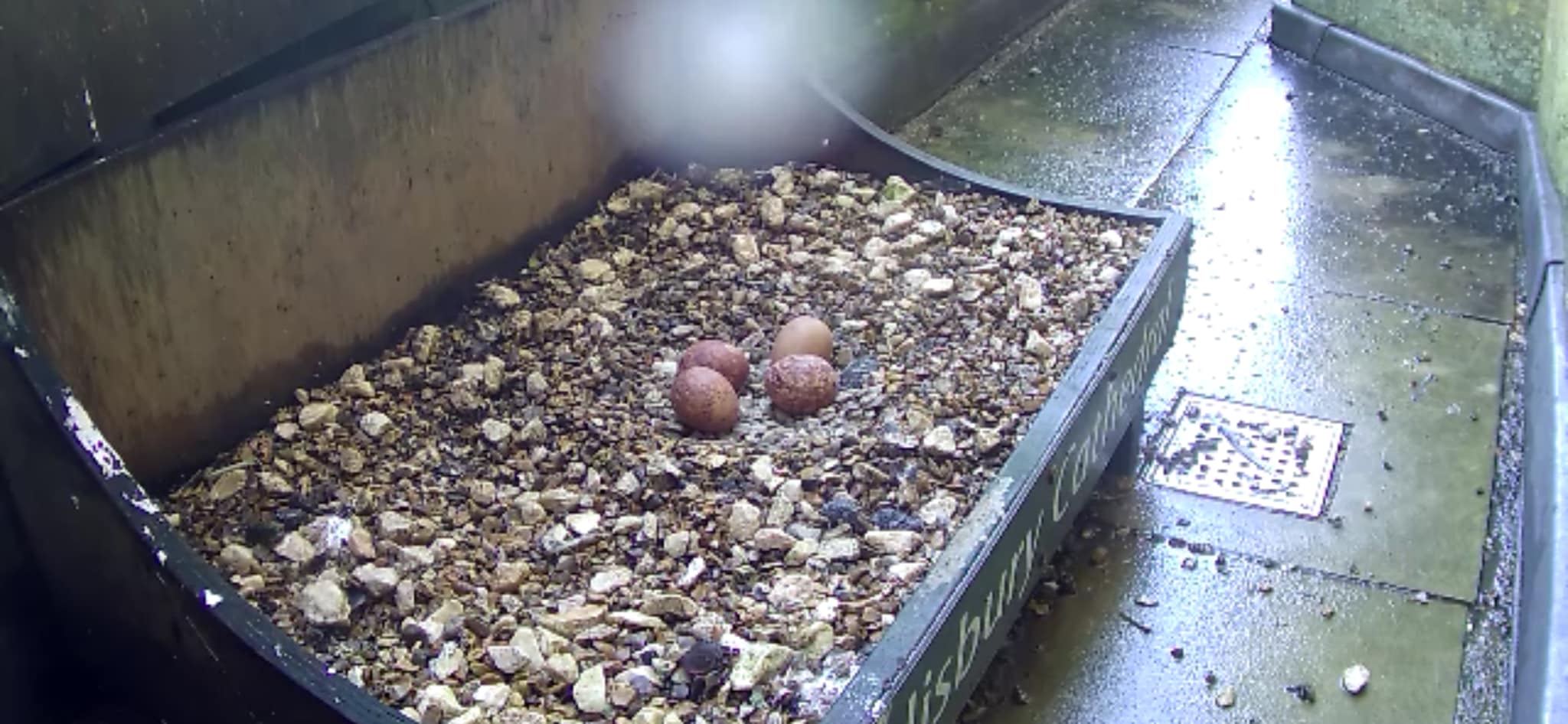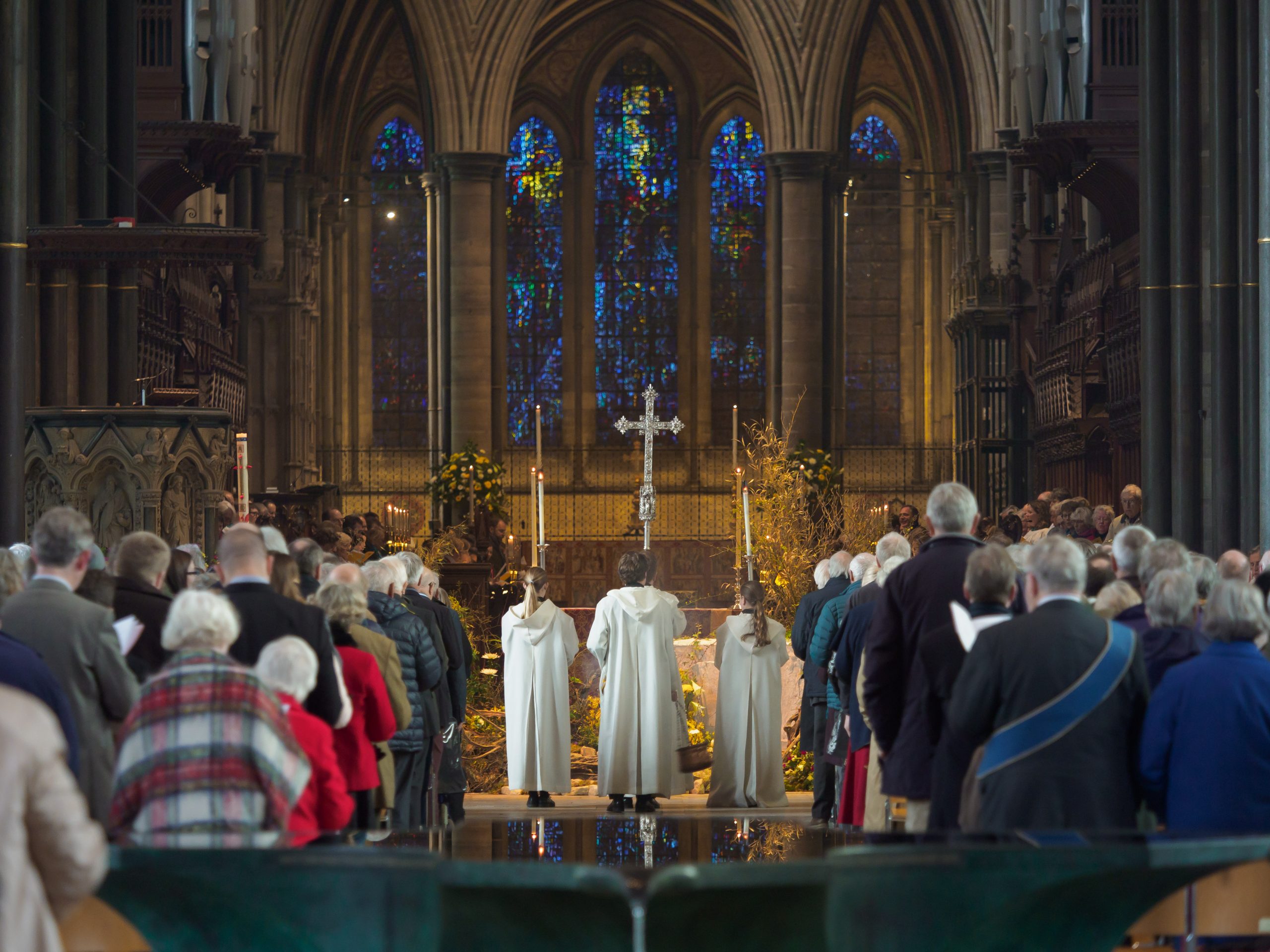Four eggs laid on the tower – Peregrine Blog 28/03/2024

As I type this, I am periodically stopping to check the live nest cam footage on the internet. It is currently absolutely teeming with rain and the adult falcon is looking extremely bedraggled on the nest box. Peregrines are of course an extremely resilient species and are well used to coping with adverse weather conditions. Prior to their relatively recent adaption to nesting on man made structures, they typically nested, and still do, on crags and sea cliff, open to all winds and weathers. Some nests in these locations do fail in very wet years, nest scrapes can get flooded and eggs chilled. Such failures in nest boxes on made structures are much rarer however. Our own nest box is a wooded structure with holes drilled in the bottom to allow for good drainage. The course gravel substrate in which the nest scrape is created also allows for good drainage. For good measure the whole structure is raised up above the walkway level on two pieces of three by two inch (if memory serves) wooden battens. Additional, as viewers of the nest cam will have noted, there is a small square metal drain cover beside the box and that drains any standing water from the stone walkway. This cover was cleared of debris shortly before the breeding season commenced, and is currently working perfectly. It and a similar one at the opposite end of the walkway can get blocked with miscellaneous prey remains when there are chicks in the nest box, and this can in cases of very heavy rain lead to some temporary flooding of the walkway. When the chicks are ringed at about three weeks old, the opportunity is taken at the same time to clear any debris from these two drain covers.
The nest cam went live in the third week of March, just in time to record the first egg laid on 21 March, followed by the second, third and fourth eggs on 23, 25 and 28 March respectively. In 2023 the first egg was laid a little earlier on 17 March. From contacts around the United Kingdom who actively monitor nests on man made structures, many with similar nest cams to ours, I gather our first egg laying date of 21 March was fairly typical for 2024. The Salisbury falcons, as do most other pairs, normally lay a clutch of four eggs, occasionally three and once a rare clutch of five. I suspect we will probably have a clutch of just four eggs this year, but I am prepared to be pleasantly surprised if a fifth egg appears in two or three days time. I am not sure the adult male will be quite so pleased however as sometimes the smaller males do struggle to cover all five eggs fully when it is their turn to incubate whilst the female goes off for a while to stretch her wings so to speak!
Peregrines typically start incubating after the third or fourth egg, so allowing perhaps about 32 days for incubation, we can perhaps anticipate the eggs to start hatching in the last few days of April. With typically about six to seven weeks between hatching and fledging, we can anticipate the first chicks fledging in mid June. Between hatching and fledging, the chicks will be ringed in the usual way, and this normally takes place when they are about three weeks old.
Regular viewers of the nest cam, and visitors we speak to at the ‘Date with Nature’ event run every year by the local Salisbury RSPB group often ask if the birds occupying the site this year are the same birds as last year or indeed in previous years. The honest answer to that is we don’t know. Adult Peregrines are remarkably similar in plumage, and whilst it is possible to tell, given a good view, adult females from adult males, distinguishing between different adult females or adult males is really very difficult and often quite impossible. Once they have reached breeding age typically after three or four years, adult mortality is perhaps about 20% in any given year. Statistically therefore it is likely that a number of the birds occupying the cathedral since they first attempted to breed in 2013 have been resident with us for a number of years. The only real way to be sure is if a bird occupying a site is ringed with either a metal BTO (British Trust for Ornithology) ring, a coloured and lettered Darvic ring, or both. Surprising to date, no birds occupying the cathedral site have been seen to be wearing rings placed on their legs form other monitored nest sites. The vast majority of chicks fledged from buildings in the United Kingdom, typically in urban locations, are ringed every year. A Peregrine WhatsApp group to which I belong frequently shows photographs of birds with coloured Darvic rings which have taken up residence at nest boxes like our own across the country. This enables us to know from which nest they fledged and how old they are. One of our own chicks fledged on the cathedral in 2021 and christened Flo with a Darvic ring TND, took up residence on a disused breakfast cereal factory in Welwyn Garden City in 2023 and bred successfully there when only two years old. Breeding at only two years old is quite unusual in itself; she is as far as I am aware still present at this site in 2024.
With, probably the fourth and last egg now laid, things are likely to be relatively quiet at the nest box for the next month or so whilst incubation takes place. That month will I am sure fly by, if you will excuse the pun, and from the very end of April until mid June viewers of the nest cam can look forward to the treat of watching the intimate life of our resident falcons and their new chicks…..I can’t wait.
Granville Pictor 28 March 2024.




